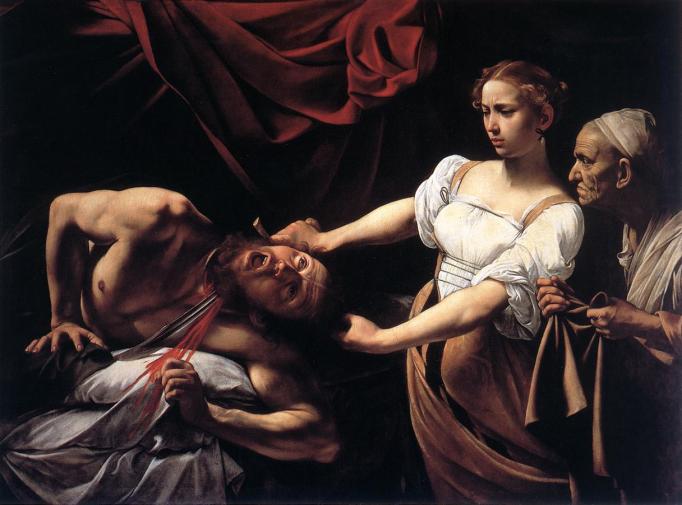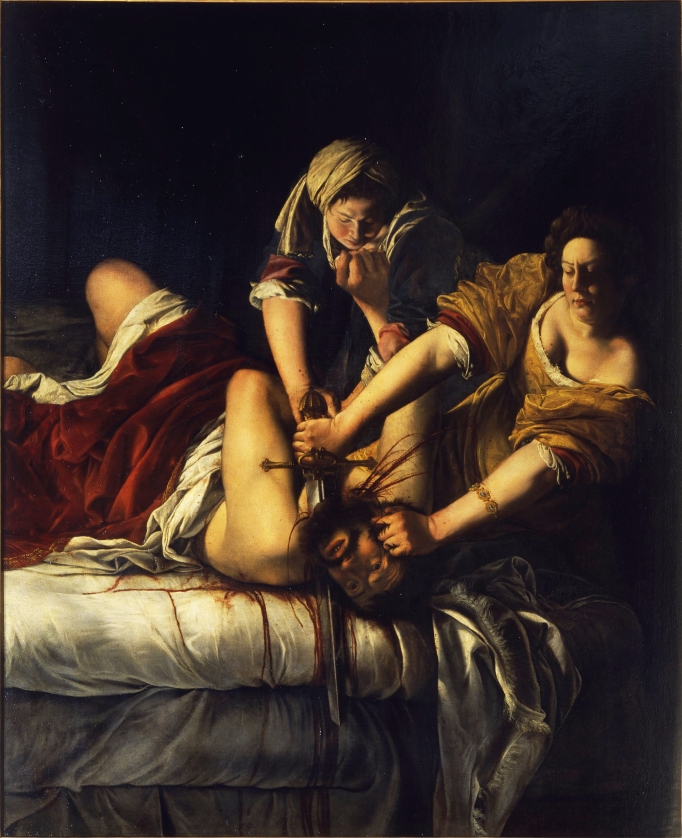I first learned about the deuterocanonical tale of Judith and Holofernes when doing some extra reading for my AP Art History class in high school. Artemesia Gentileschi’s depiction of the story is the first one I saw, and I quickly became obsessed with the figure. It was especially fascinating because being in AP Art History at the time, I was just truly uncovering the way the long story of humanity’s artistic expression is one filled with recurring tropes, iconic figures, and cycles of action and reaction. With Judith, I saw a heroine who had been recreated over and over, and whose meaning changed over time.
The story, in brief:
- Holofernes is an Assyrian general who is going to destroy the city of Bethulia.
- Judith is a devoted Jewish woman and a beautiful widow.
- She infiltrates Holoferne’s camp with her maid. She charms him, earns his trust.
- After a banquet, she is alone with a drunk Holofernes in his tent.
- SHE DECAPITATES HIM IN HIS BED!
You can read a more detailed version here.

By Caravaggio, 1599 (via Wikipedia)
There are tons of depictions of this story varying in style and subject, with Judith holding the head, her maid displaying it on a platter, or in the act of cutting Holofernes’ head off. Caravaggio’s version, above, may be most recognizable. Here Judith is in the middle of the act, blood spurting as her sword slices; yet, the gentle widow in white does not appear to be under much strain physically or emotionally. This is different in Artemesia Gentileschi’s depiction of the scene, below, where you can see that the decapitation is a laborious act; her maid is assisting in the task, and Holofernes is struggling. The other interesting aspect of this painting is that it may be self-insertion. Artemesia appears to have depicted herself as Judith. Holofernes is modeled on Agostino Tassi, her artistic mentor and her rapist. In 1612, Tassi was brought to court for the assault and after months was found guilty but hardly punished, even though other crimes were discovered during the trial. Artemesia suffered even more trauma throughout the case from humiliation to physical torture. Her paintings often show heroines, dramatic conflict, or exhibiting intense emotion. (See also: her painting of Susanna and the Elders which strays from the typical flirting woman, and which x-rays have revealed may have initially been even more extreme.)

Judith Slaying Holofernes (Uffizi Version) by Artesmsia Gentileschi, 1620 (via Wikipedia)
Here are some more of my favorite pieces showing Judith beheading Holofernes, from the sixteenth to twenty-first century.
Left: Donatello, 1460. Commissioned by the Medici family and symbolic of Florence’s triumph against tyranny, very similar to depictions of David and Goliath.
Right: Botticelli chose to illustrate Judith’s triumphant return home to Bethulia.
__________
Left: Barthel Beham‘s odd posing decision in the 1525 engraving, Judith Seated on the Body of Holofernes. This one seems strange; as this thesis puts it,”Neither the textual nor the visual traditions explain Beham’s choice to perch the chaste woman on top of her slain enemy, so what sources inspired the printmaker?”
Right: The heroically disrespectful stance in Giorgione‘s 1504 oil painting.
__________
 “Judith and Holofernes” (2012) © Kehinde Wiley
“Judith and Holofernes” (2012) © Kehinde Wiley
This version by Kehinde Wiley is a modern use of the story of heroine and tyrant. Wiley’s vibrant style is amazing; I’d encourage reading this article about him and looking through his work.
__________
Here is her place setting in Judy Chicago’s 1970s massive feminist work, The Dinner Party, which I saw last year while at the Brooklyn Museum.
__________
I noticed these two near each other during a field trip to the Ringling Museum of Art in Sarasota. The left is by Fede Galiza, 1596; the right, by fellow Italian Francesco del Cairo, 1635.
__________________
Judith is a symbol of the underdog, of the overlooked, of the Power of Women, appropriated as a feminist icon, and a vision of triumph. Whether depicted as ambivalent or fearless, seductive or desexualized, feminine or doing arduous masculine work, illustrated in Renaissance or contemporary style… Judith is bold, and my favorite figure to spot in museums.
From Judith’s Song of Victory, in chapter 16 of the Book of Judith
4 He boasted that he would burn up my territory,
and kill my young men with the sword,
and dash my infants to the ground,
and seize my children as booty,
and take my virgins as spoil.
5 But the Lord Almighty has foiled them
by the hand of a woman.
7 For she put away her widow’s clothing
to exalt the oppressed in Israel.
She anointed her face with perfume;
8 she fastened her hair with a tiara
and put on a linen gown to beguile him.
9 Her sandal ravished his eyes,
her beauty captivated his mind,
and the sword severed his neck!







